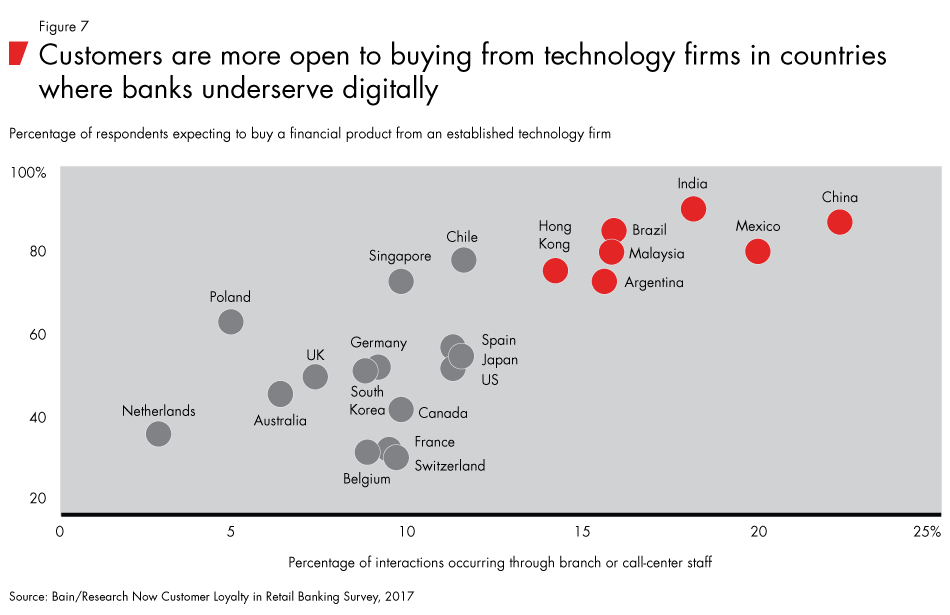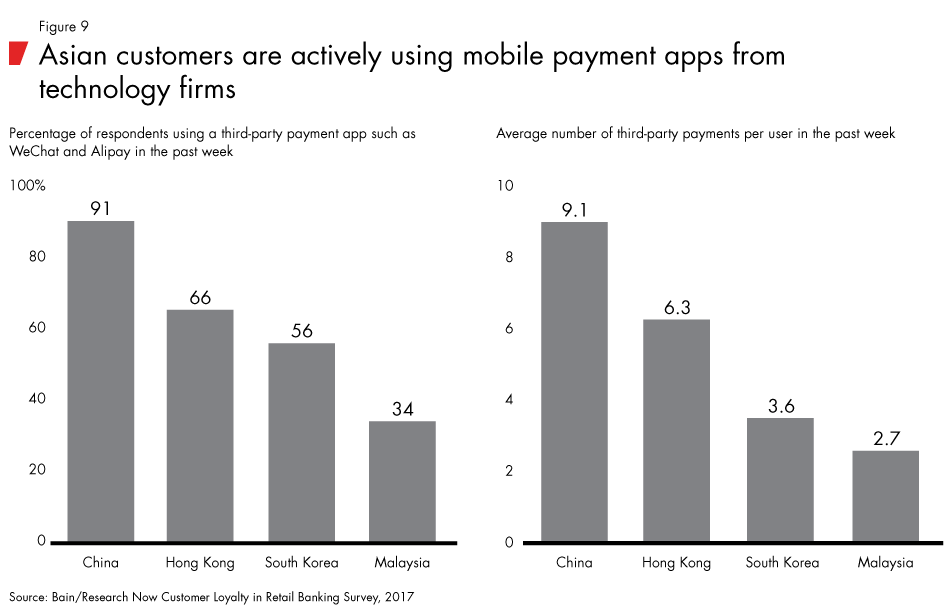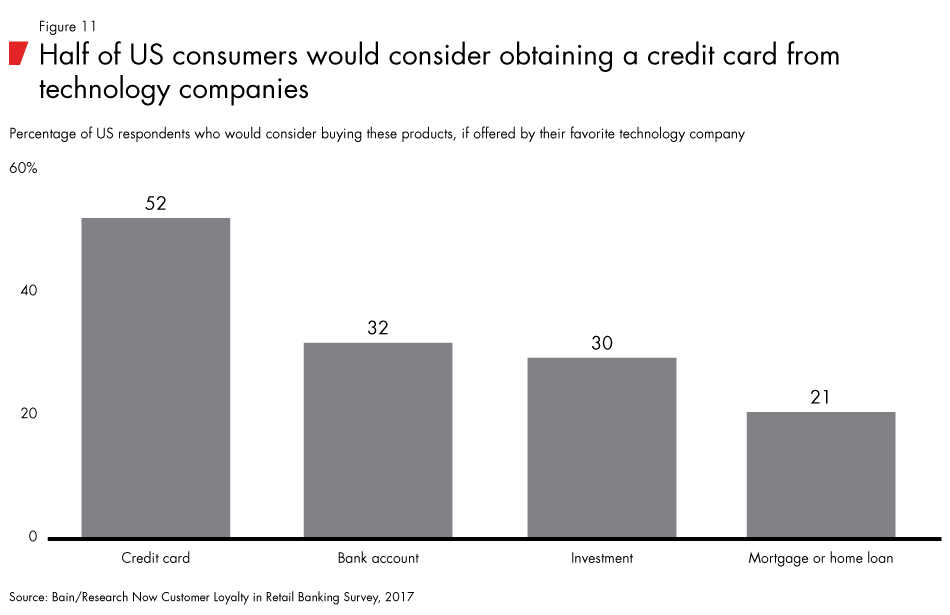Report

Explore Bain’s latest Customer Loyalty in Banking insights.
Amazon’s acquisition of Whole Foods is an audacious plunge into grocery in the US. More quietly, the company has also been moving into financial products, including Amazon Cash, which gives customers the ability to deposit cash directly to their Amazon accounts from more than 10,000 retail locations throughout the US; and lending more than $1 billion in the past year to small merchants selling through its online platform.
We already see the dynamic of technology firms moving into banking in Asia. In China, e-commerce giant Alibaba has amassed the world’s largest money-market fund, issued $96 billion of loans in five years and grown Ant Financial to a market capitalization roughly equivalent to the ninth-largest bank in the US. Alibaba also started online bank MYbank, which approves loans instantly, using automated processes based on consumers’ financial history with Alibaba. Japan’s main e-commerce giant, Rakuten, operates the country’s largest Internet bank and third-largest credit card company by transaction value. Financial services now account for nearly 40% of Rakuten’s revenue.

In Search of Customers Who Love Their Bank
With banks facing increased competition from tech firms, our latest report examines how the banks can focus on what customers value most.
As these examples illustrate, it turns out that retail banking is being upended not by nimble fintech start-ups, but by established tech firms. Many of the tech giants possess the ingredients of success: digital prowess, large customer bases, organizations well versed in improving the customer experience, and ample leeway to extend their corporate brands into banking.
Should banks worry? They do appear to be vulnerable to losing the special status they once enjoyed. Banks have a strong reservoir of trust, to be sure. But consider that US and UK consumers ranked PayPal and Amazon nearly as high as banks for trust with their money, in Bain & Company’s new survey of 133,171 banking customers in 22 countries.

How Banks Can Defend Against the Threat from Big Tech
Banks can respond by focusing on the customer experience.
Many consumers are open to buying financial products from established tech firms (see Figure 1). The greatest latent demand exists in countries where the bank branch experience is more time-consuming and cumbersome, such as India and Mexico; there, 91% and 81% of respondents, respectively, expressed a willingness to run their finances through major tech firms. By contrast, where banks have taken some of the pain out of banking by digitalizing most routine transactions, as in the Netherlands, they have inoculated themselves to some extent against the threat.
Demand for alternatives to traditional banks will only grow, as younger respondents in our survey showed the greatest willingness to try these offerings. Moreover, more than one-quarter of US respondents would consider using voice-controlled assistants for their everyday banking, and Amazon currently dominates the voice-enabled speaker market with its Alexa assistant on the Echo device. Given that Amazon, Alibaba and others already sell payment services, credit cards and loans, it’s plausible that they will offer a suite of retail banking services in the near future.
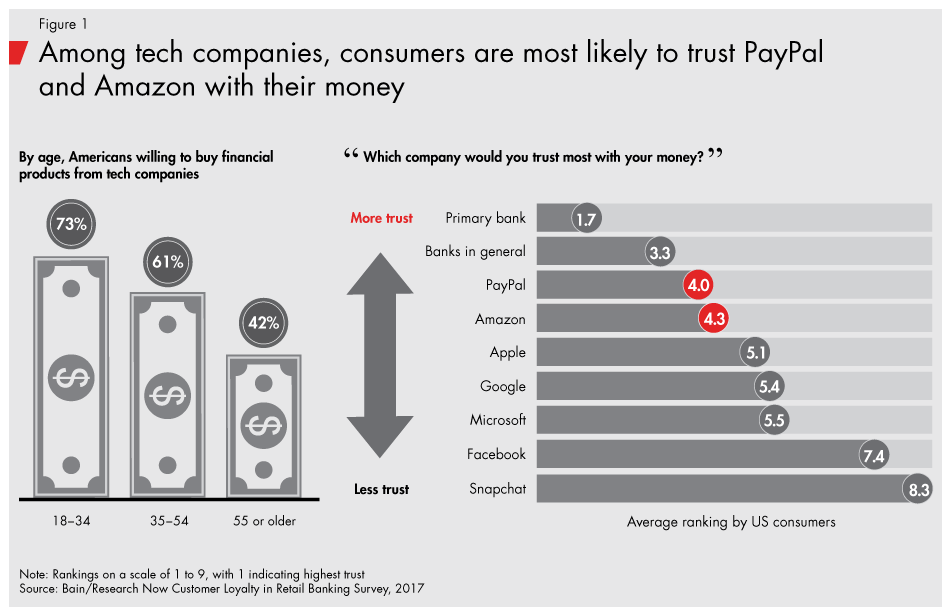
The perils of digital lag
Banks have a stiff challenge with meeting customer expectations for digital tools. Consumers young and old prefer using websites and mobile applications for their routine banking transactions, which tend to be the most frequent interactions. In the UK, for example, consumers give an average Net Promoter Score® (a key metric of loyalty) of 35 to their routine transactions done digitally, higher than the 20 points for transactions done through employees at the branch or call center. People get annoyed when they’re forced by bank policies and processes to use additional channels for everyday banking business.
Refining the website and mobile app to be convenient, multifunctional and easy to use with just a few taps or strokes will be critical to earning customers’ advocacy and loyalty. Yet on these basic characteristics, banks’ mobile apps and websites fall short in the view of many respondents. In the UK, only 45% of respondents said their primary bank’s website lets them do everything they need, or is easy to use (see Figure 2).
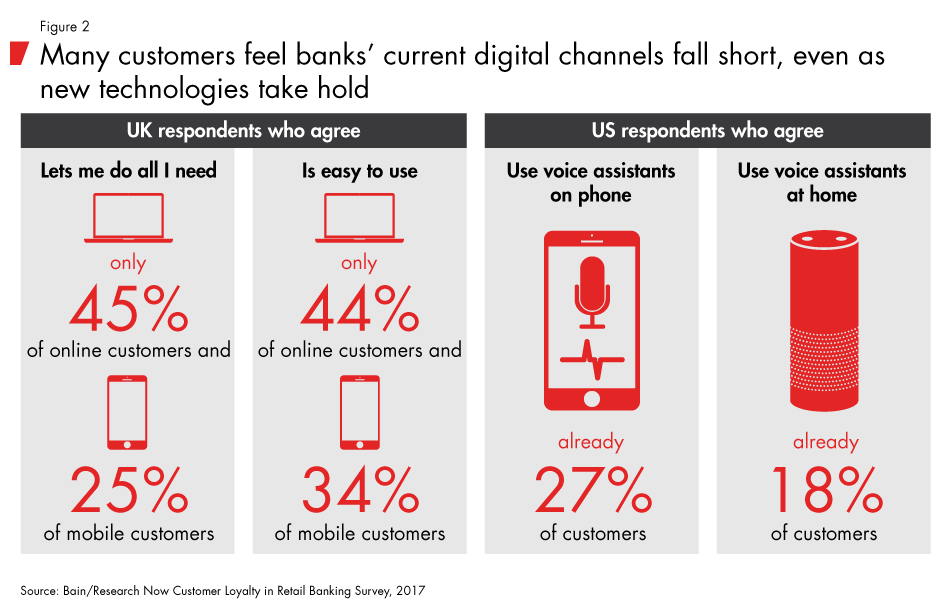
Beyond the basics, banks have barely touched some technologies that have reached a tipping point in consumer markets. A large group of respondents said they use voice assistants such as Siri, Alexa or Google Assistant on their smartphones (one-quarter of all US respondents, for example, and an even higher share among young adults) or Alexa or Google Home at home (almost one-fifth of US respondents).
Just as intriguing is the 5% to 6% share of respondents in Australia, the UK and the US already using voice assistants for banking; between one-fifth and one-quarter are open to trying the technology for their banking in the future. A few banks have made progress in this regard, including Santander in the UK and Capital One in the US. Last year, Capital One launched functions using Alexa skills, which employ a chatbot that works with Alexa. These chatbots have some constraints, including the need for explicit commands, such as “What’s my payoff quote?” for an auto loan. But USAA recently introduced an Alexa offering that lets members speak conversationally. Banks that master the digital basics will be able to further secure customers’ loyalty by quickly putting the new technologies to practical use in test-and-learn prototypes that can be improved in a few iterations and then broadly rolled out. And banks should be sure to automate back-end processes behind the new technologies to avoid adding complexity along with the new channels.
Gerard du Toit, a partner with Bain's Financial Services practice, discusses how leading banks are breaking down organizational silos to create cross-functional teams that are dedicated to delivering the best possible customer episodes.
Beyond the loyalty benefits, there are also compelling cost reasons to accelerate development of digital channels that can handle more routine transactions and move them out of expensive branches and call centers. Each mobile interaction incurs a variable cost that’s a tiny fraction of the cost for a teller or call-agent interaction. As interactions migrate to mobile, a bank needs fewer tellers and call-center agents. The five largest banks in Mexico, for instance, could eliminate $500 million in costs if they reached the level of mobile and online banking usage of their counterparts in the Netherlands. Dutch banks began to reconfigure their branch networks a decade ago, as the country’s strong broadband infrastructure and shift to cashless commerce allowed consumers to adopt mobile banking early on.
Banks in other countries have equally large opportunities to take out costs. In the US, for example, 40% of respondents went to a branch teller at least once in the previous quarter to make a deposit, compared with 21% using digital channels and 18% using automated teller machines (ATMs).
The lower costs and high customer advocacy for digital channels serving routine interactions create a virtuous circle (see Figure 3). The more transactions that digital channels accommodate seamlessly, the more customers will use them instead of the call center or branch. And the reduction in “bad” call and branch volumes allows banks to reinvest more to further improve digital channels, while reserving their employees for the knottiest problems.
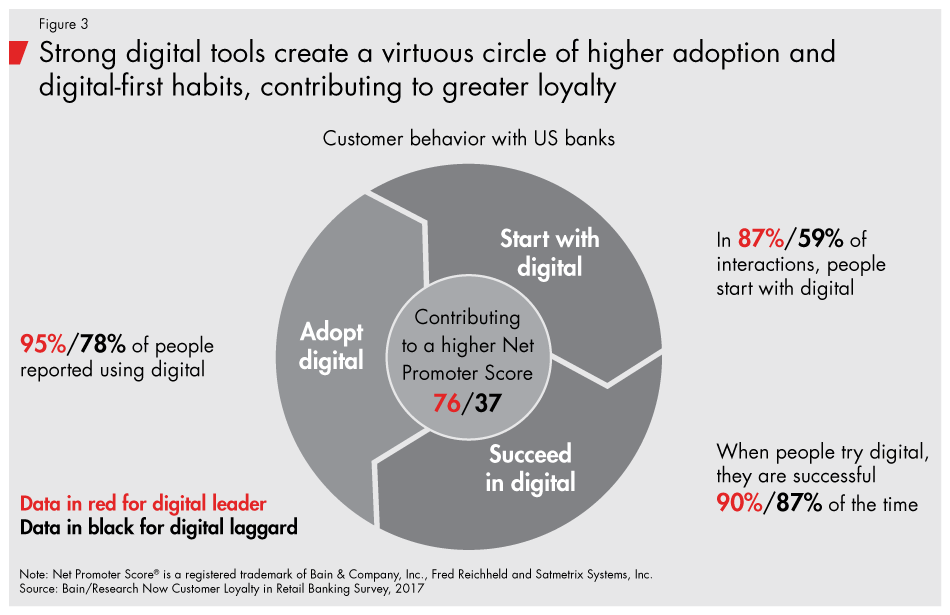
Citibanamex has taken on the “bad” volume challenge, which is particularly vexing in Mexico. The bank reckoned that its customers and employees were spending 5 billion minutes per year at branches, with the vast bulk of that time on the customers’ end. This waste took a toll on the bank’s cost-to-income ratio and ultimately on profits, as well as on both customer and employee advocacy. Through a combination of initiatives ranging from simplifying online forms and printing formats, to migrating more transactions to ATMs, to reducing wait time at teller windows, Citibanamex freed up 1 billion minutes, giving a major boost to customer satisfaction and employee advocacy.
Cost implications also show up in such nonroutine events as disputing fees. In the US, for instance, there’s a significant gap between the leading and the lagging banks in the incidence of these dispute events. Laggards not only suffer from having more detractors among customers, they also bear roughly twice the cost of resolving the dispute as the leaders do. In some cases, this can exceed any differences in the revenues collected from the fees themselves. It’s better to eliminate such events in the first place.
Organizing around customer episodes, not products
We have seen some banks handle these challenges by organizing in a new way, around how customers experience the business. That’s a marked departure from the standard, internally oriented approach to organizing around products and functions, such as the checking account or the risk-management function. As part of shifting to the customer experience, a few pioneering banks have adopted as a key unit of management the “episode”—activities that customers perform when they have a task to complete or a need to fulfill (see Figure 4). Typical episodes include “I want to pay a bill online,” or “I want to buy a home” or “I want to dispute a fee.”
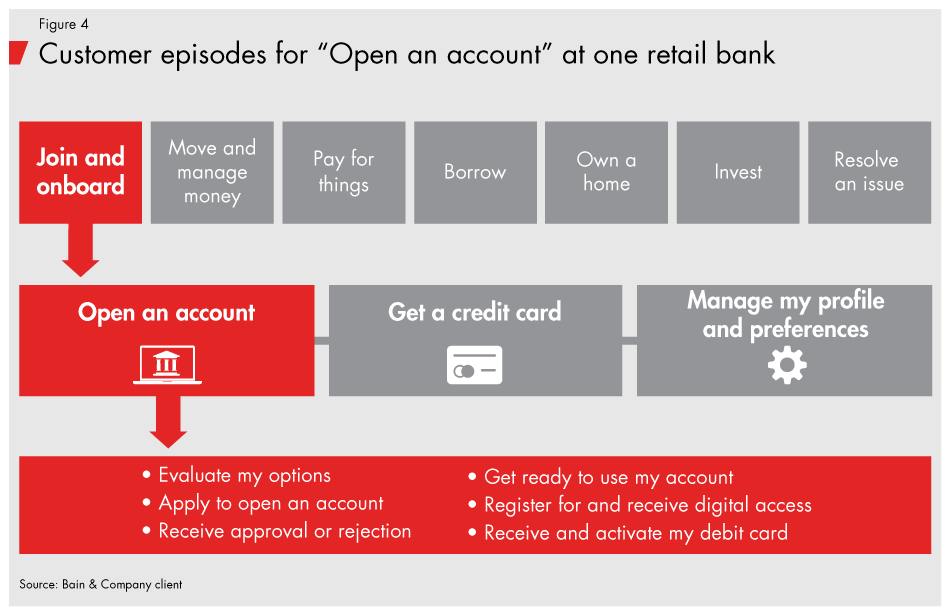
Design and management of each episode occur through small, cross-functional teams that are responsible for owning and improving an individual episode. Teams typically use Agile methods to arrive quickly at a minimum viable product, gathering and baking feedback from customers into successive versions of the episode before rolling it out broadly. One bank has managed to take Agile episode management to scale, with more than 250 active teams. The bank is realizing substantial gains as a result. For instance, one team generated an auto-finance mobile prototype in one week, a project that previously would have taken at least six months.
Different episodes require a different blend of digital and human processes, tuned to the unique considerations of each episode. High-stakes, emotional moments of truth, such as handling a complaint, demand outstanding customer service, as our survey respondents strongly prefer working with employees to dispute a fee or resolve a problem. Low-stakes, but frequent, episodes such as reviewing one’s account activity should be as fast and convenient as possible through digital channels. Banks should work to reduce the frequency of bad episodes, and treat episodes involving sales as an opportunity to reinforce the bank’s brand.
You have to ask for the sale
In fact, episodes that involve buying financial products represent huge untapped opportunities for banks, which they can realize through more personalized selling.
Hidden defection—purchasing an additional banking product from a competing bank—takes place everywhere, totaling 25% to 51% of additional products, depending on the country. Credit cards, loans, insurance and investments are the most purchased categories at competitors, whereas the primary bank tends to keep a higher share of low-value deposit accounts.
To stem the tide of hidden defections, our analysis of the survey data shows that banks should consider more, and more targeted, marketing and sales pitches. In the US, for instance, 42% of defectors said they bought from a competitor bank because they received an offer or saw an advertisement. Only one-fifth were actively researching when they decided to buy the product. Just as striking, more than half would have purchased from their primary bank if the bank had made an offer (see Figure 5).
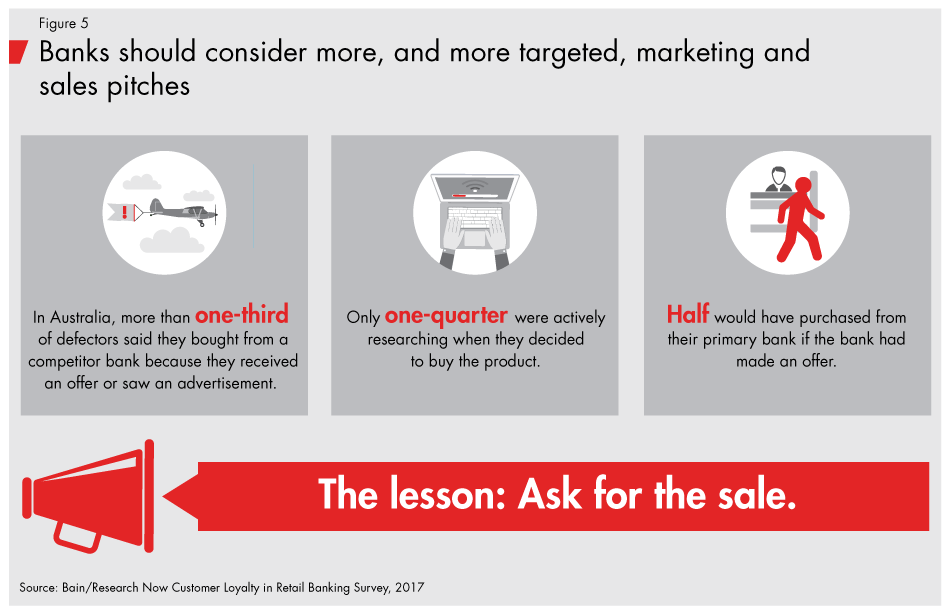
The lesson: Ask for the sale. Banks have copious data on their customers’ risk profile and stage of life, which allows them to present the right offer at the right time and place—before competitors step in and poach a willing customer. Since more consumers tend to purchase credit cards, investments and other secondary products more frequently through digital channels than they do when buying primary products, it follows that banks could ramp up their digital marketing efforts.
• • •Banks’ efforts to build out websites and mobile apps have made for an intense competitive game within the sector. An entry by Amazon or other tech firms into banking would take the competition into a different league.
Consumers’ expectations keep rising as people grow accustomed to simple, convenient digital channels in other parts of their lives. If banks don’t reorient their approach and radically accelerate their rate of progress, loyalty will suffer, and they will watch technology firms poach more business. Meanwhile, their economics will erode as too many routine transactions continue to flow through expensive branch and call-center networks.
Bank employees, used judiciously, will also figure in this competitive battle, as long as they are deployed to resolve complicated problems or serve high-value customers who merit personalized attention. Banks that go a step further to mobilize small teams around individual customer episodes stand to steadily earn greater advocacy and loyalty, the best defense against incursions by technology firms.
Consumers to technology firms: Bring on the financial products
- Customers are surprisingly amenable to trying financial products offered by technology firms, especially large, established firms. While some consumers express willingness to try such products from start-ups, there’s a 10- to 40-percentage-point gap across countries between large firms and start-ups.
- Younger customers show the greatest willingness to try such offerings, but a large share of older customers in all countries also are comfortable with the idea. Credit cards get the highest expression of interest, followed by a basic account.
- Interest in tech firms’ offerings is greatest in countries where customers have long used nonbank payment systems, such as India and China, or where it’s time-consuming to use branches, as in Mexico. People in these countries also have been underserved by banks in terms of digital tools, compared with leading countries such as the Netherlands.
- Among the major technology firms, PayPal and Amazon rank nearly as high as banks for trust with the money of US and UK consumers.
- Consumers in many developing countries give higher loyalty scores to the digital tools they do have, relative to channels where they interact with employees. This may suggest pent-up demand for digital where branches are crowded or offer a poor experience. And where Net Promoter Scores for mobile fall well below the scores for online, as in Mexico and Germany, banks may want to add more of a human touch to the mobile experience.
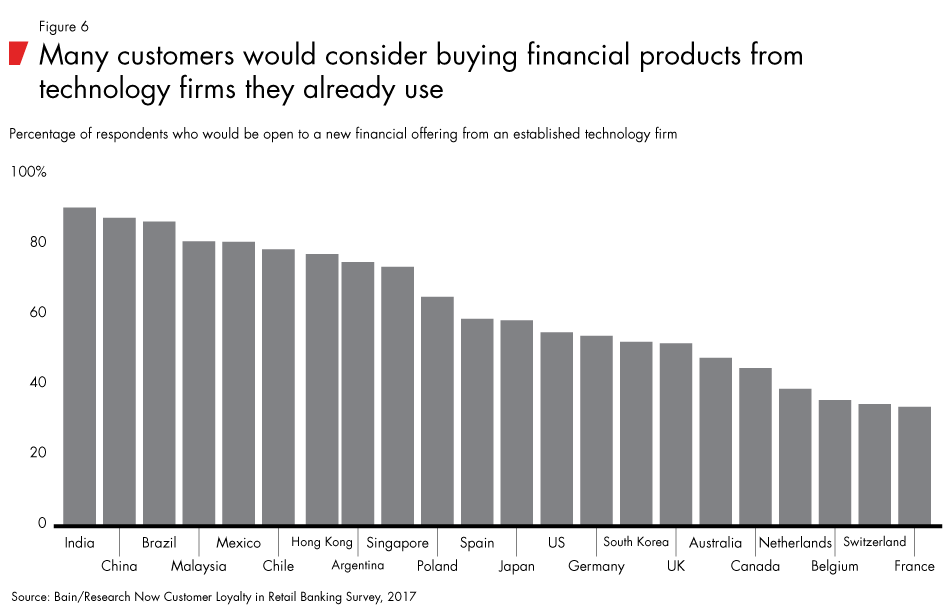
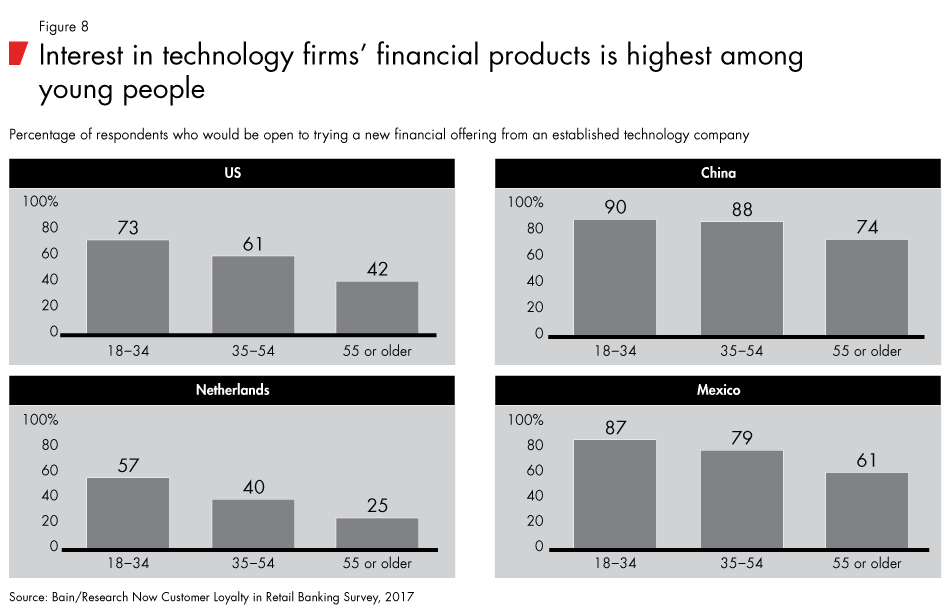
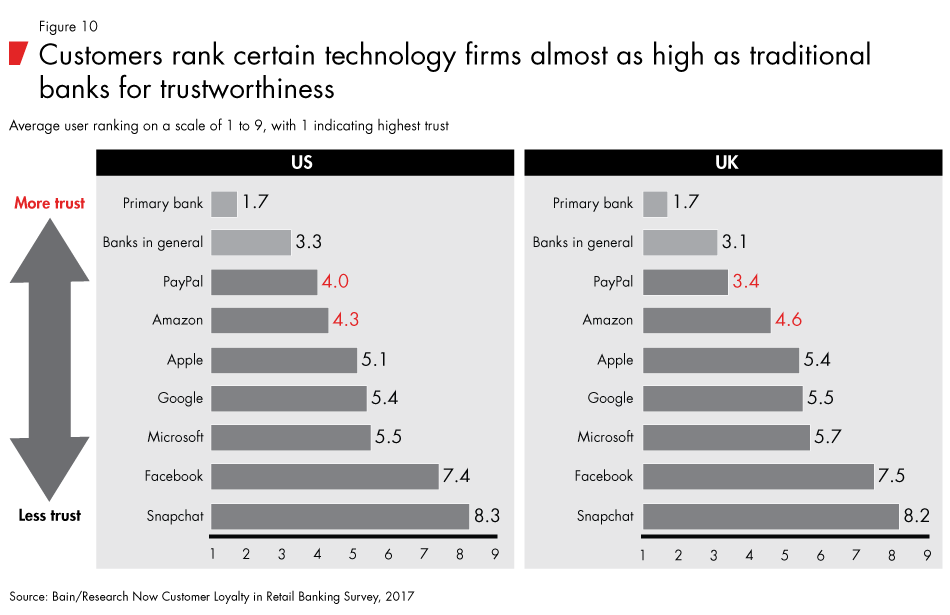
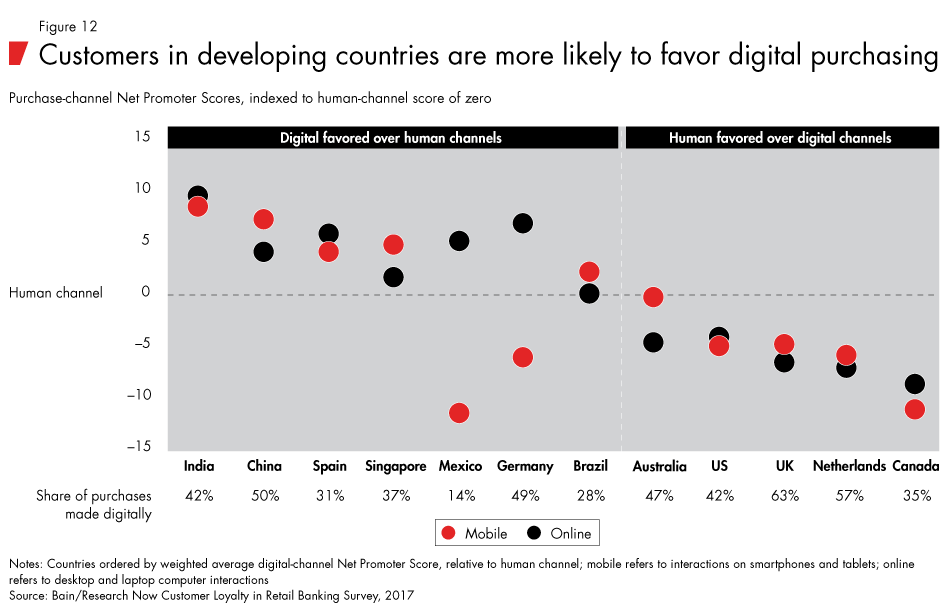
Banks still lag in digital basics, especially with mobile
- Banks have been trying to migrate transaction volumes out of the branch and call center to digital channels over the past five years, but the results of such efforts have leveled off as banks picked off the easiest targets. Banks in Hong Kong, China and India have made the greatest progress in reducing the number of interactions requiring employees.
- Yet banks in most countries still have a long way to go in this migration, compared with “self-serve” leaders in the Netherlands, Poland and Australia. In the US, for example, 40% of respondents went to the branch teller at least once in the past quarter to make a deposit, compared with 21% using digital channels and 18% using ATMs.
- Migration to digital proves well worth continued efforts. Routine transactions that require bank staff not only cost 20 times more than those done online or through mobile, but consumers also prefer to handle routine banking business digitally.
- Cost-reduction opportunities remain large and well within reach. In Mexico, for instance, the top five banks have an opportunity to take out more than $500 million in cost from traditional branch and phone channels, by performing at the best domestic and international benchmarks.
- Even within markets, there’s a large gap between the leader and laggard in the percentage of deposits made digitally.
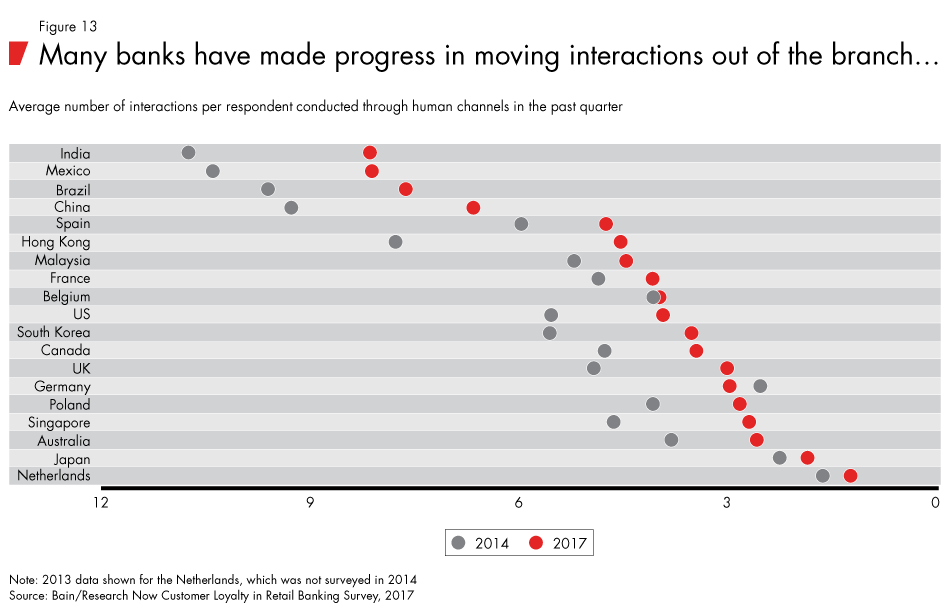
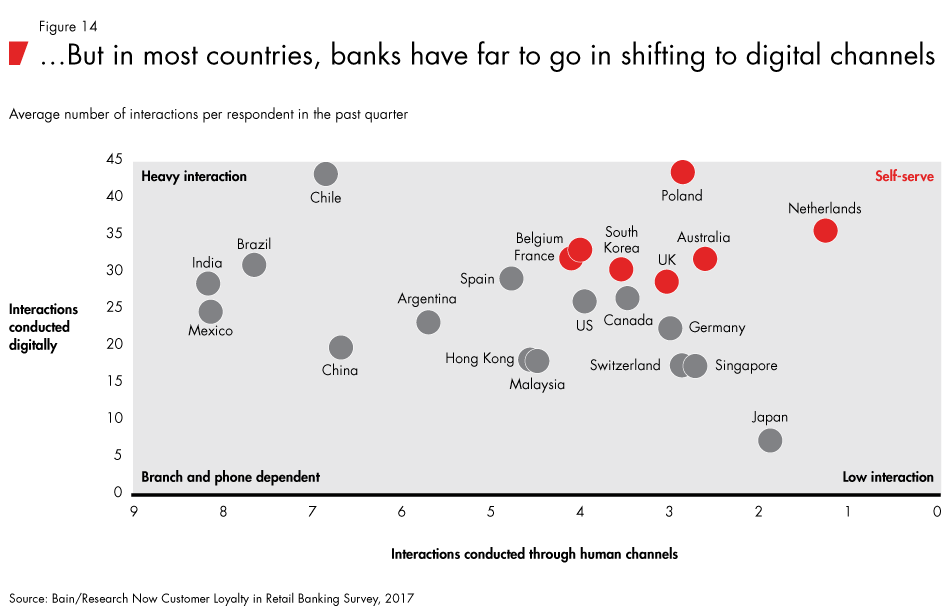
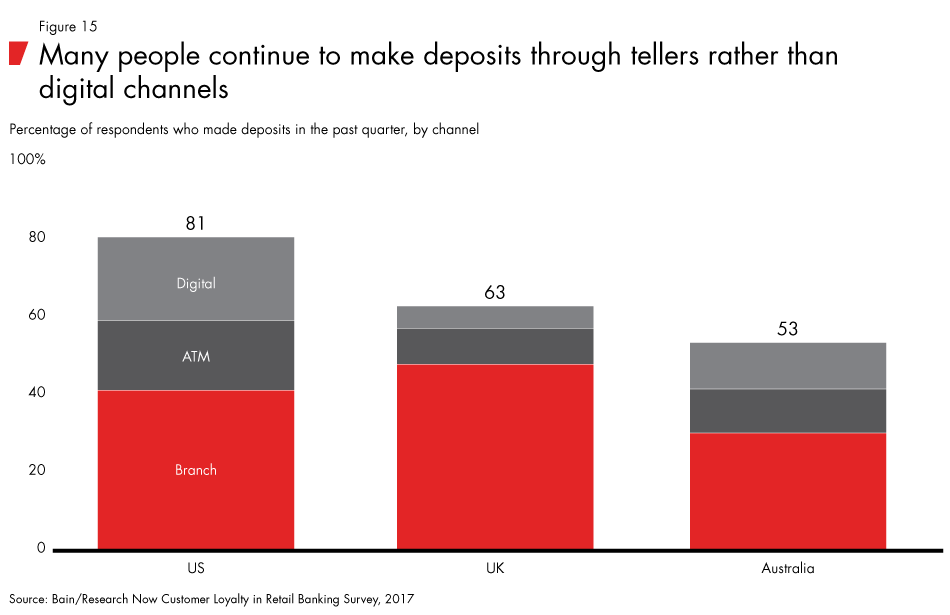
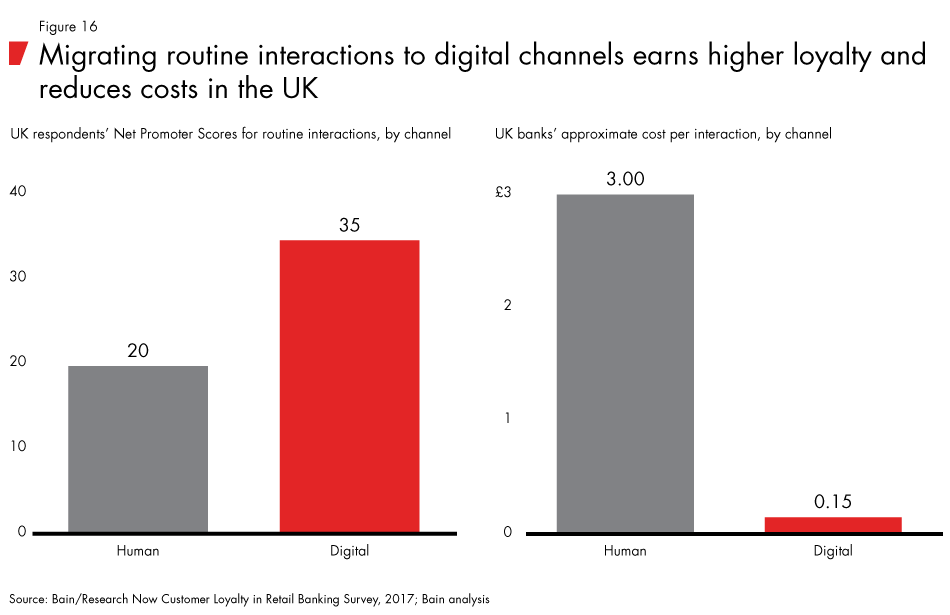
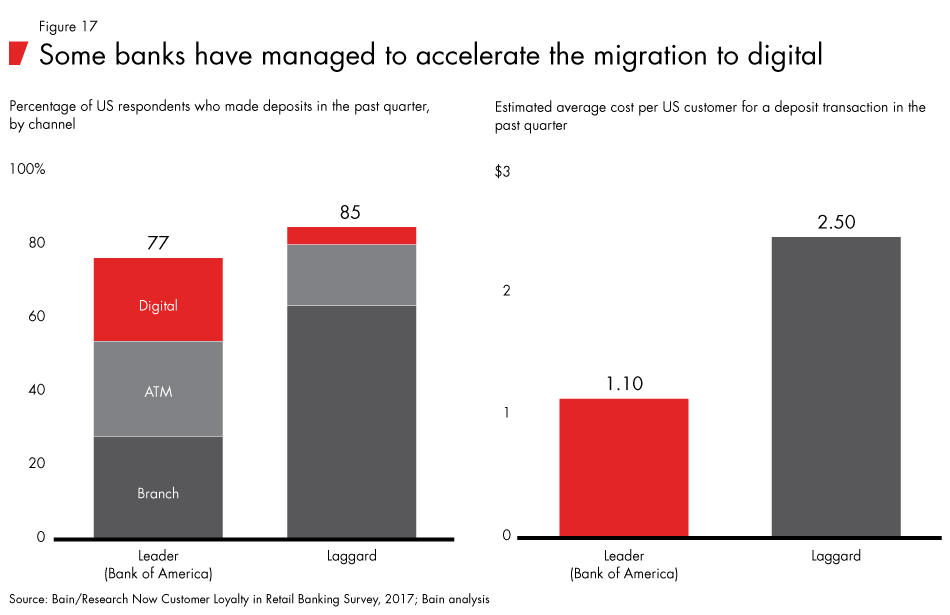
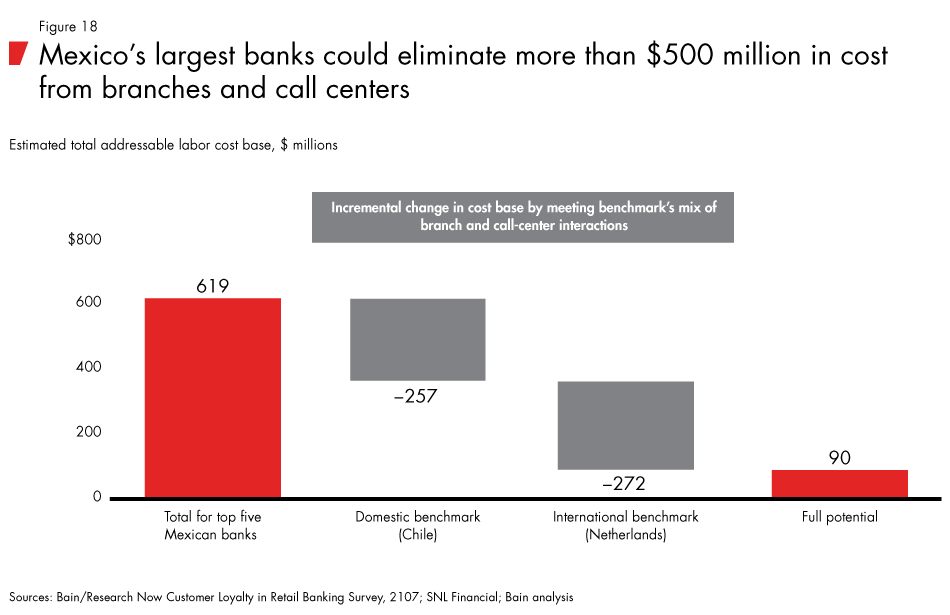
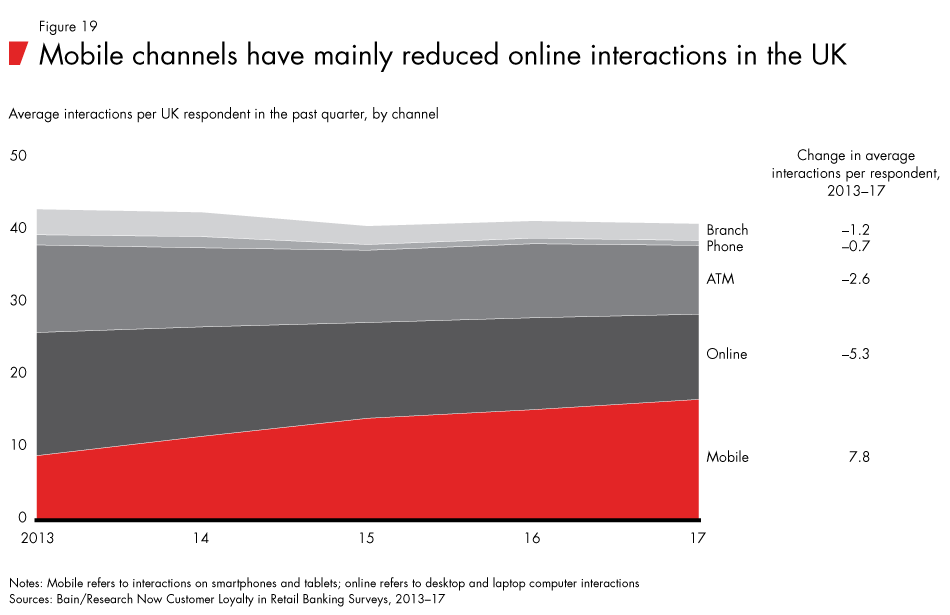
AI-based consumer technologies go mainstream
- Consumers used to convenient, high-functioning digital tools in other areas of their lives, such as retail purchases, want banks to deliver at an equally high level—yet are often disappointed. Fewer than half of UK respondents said their bank’s website lets them do everything they need, or is easy to use. The share is even lower for banks’ mobile apps.
- Turning to newer technologies, a large share of customers use voice assistants on their smartphones (one-quarter of US respondents) or at home (almost one-fifth). Young adults are the most active users of such voice assistants as Amazon Echo/Alexa and Google Home.
- Some 5% to 6% of respondents in the US, UK and Australia already use voice assistants for their banking, and between one-fifth and one-quarter are open to trying the technology for banking in the future. Many banks have put the technology in their innovation pipeline, but to date only a few banks, such as Santander UK, Capital One and USAA, actually use it in market.
- Consumers won’t embrace all new digital technologies, however. Use of both online chat and videoconferencing, for instance, has tapered off over the past two years. While many banks have pushed those technologies, in part because they wanted to reduce workloads in branches, the technologies have not sparked broad consumer participation.
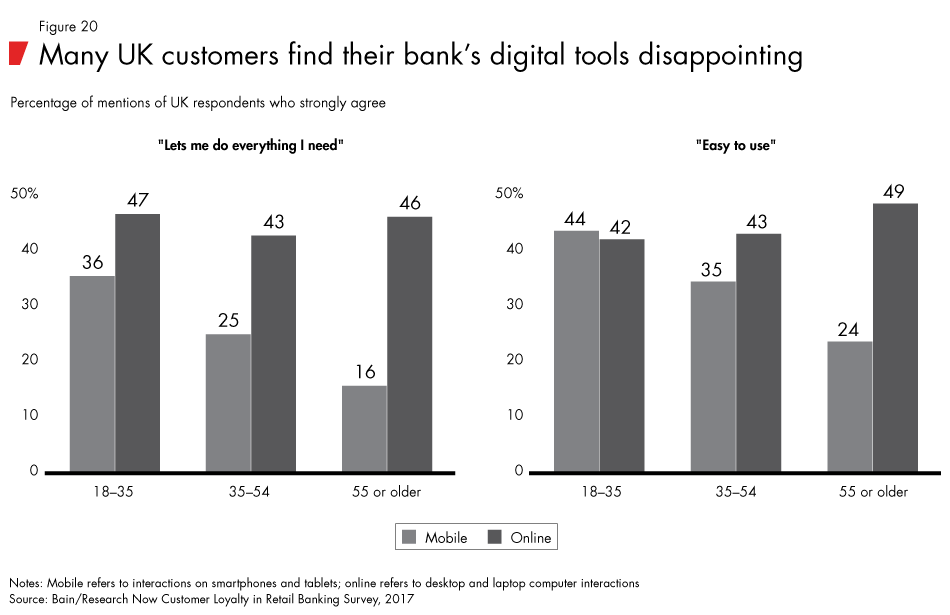
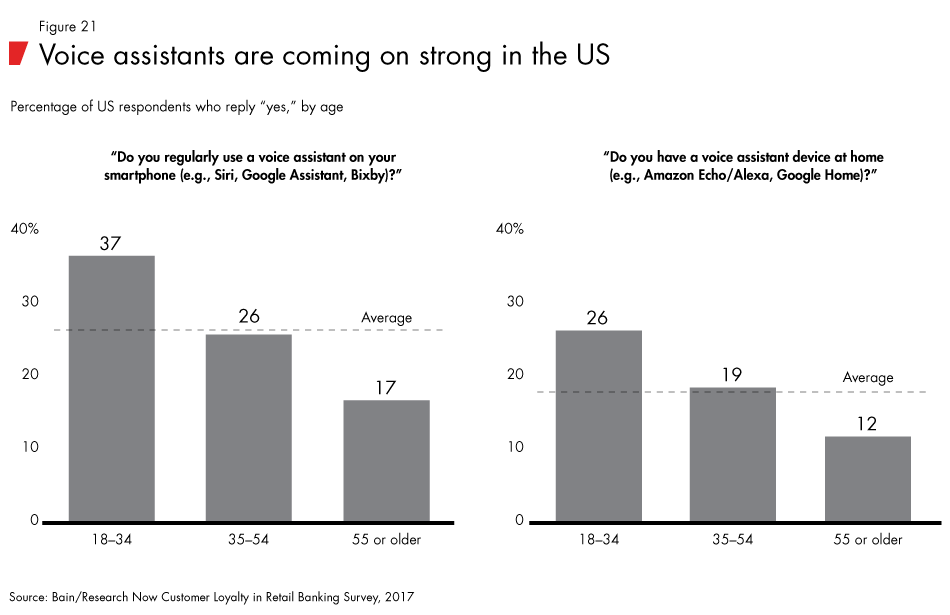
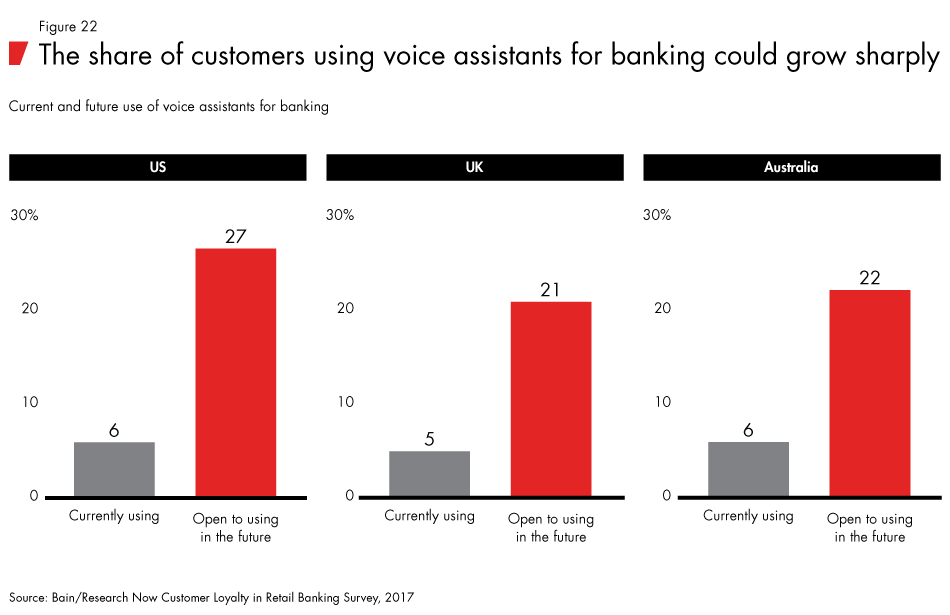
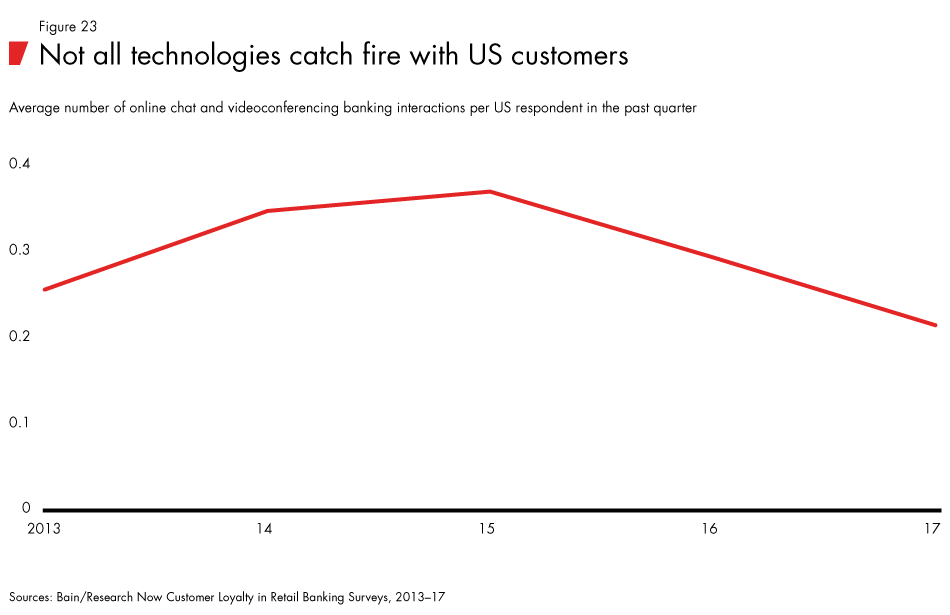
Different strokes for different customer episodes
- Consumers encounter many episodes during their banking, from routine bill payment to resolving a stolen credit card, and different types of episodes require different management strategies. Fee disputes don’t occur often, but have high stakes and thus a strong propensity to create detractors among consumers. Bill payment and money withdrawal, by contrast, might be less emotional, but occur frequently. Banks can earn greater loyalty by reducing the volumes of unnecessary transactions, making routine interactions easy and convenient, and improving the service experience of high-stakes episodes.
- When consumers make routine banking transactions, they prefer digital channels to branch or phone channels. Conversely, they give higher Net Promoter Scores to employee channels for emotive episodes like resolving a problem.
- All age groups have similar usage rates of digital channels for their routine interactions. But younger customers are much more likely to try digital channels for sales, disputes and resolutions.
- For routine episodes, the great majority of customers complete their business digitally. When they fail to complete the episode digitally and must switch to speaking with bank staff, they give much lower loyalty scores for the episode than when they succeed.
- There’s a different dynamic for emotive episodes. Only half of respondents try digital first, and only one-quarter succeed in handling the issue. When they subsequently switch from mobile to an employee channel, Net Promoter Scores for the episode actually rise. When they switch from online, those scores decline. Consumers have higher expectations for completing their business online than through mobile.
- Top-performing banks have fewer disputes, resolve those they do have faster and use digital channels better. As a result, they spend much less on disputes.
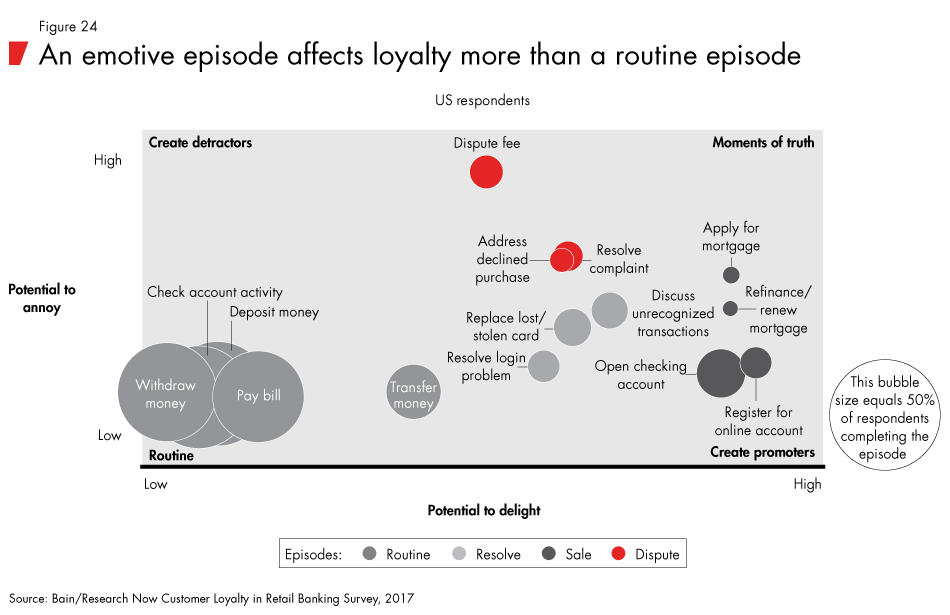
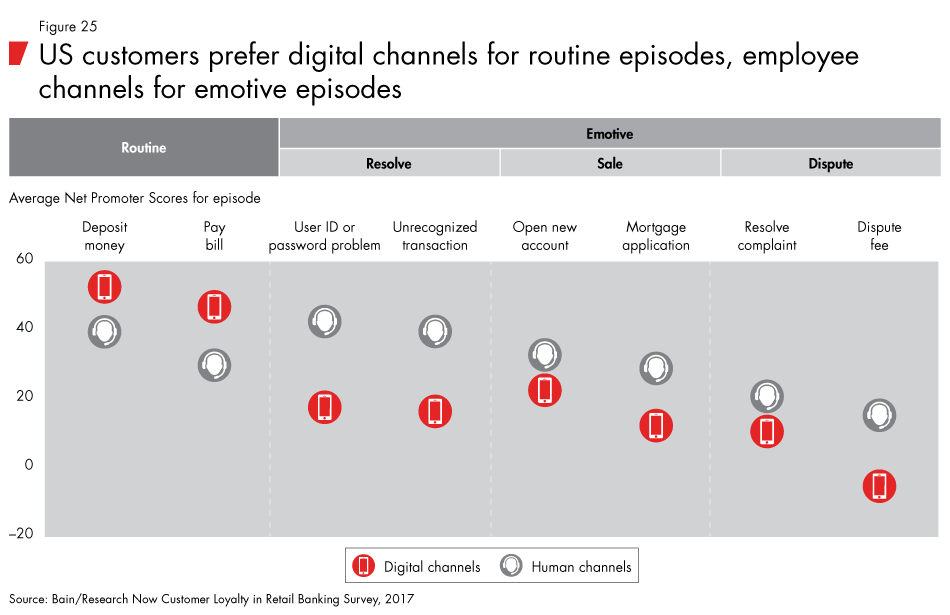
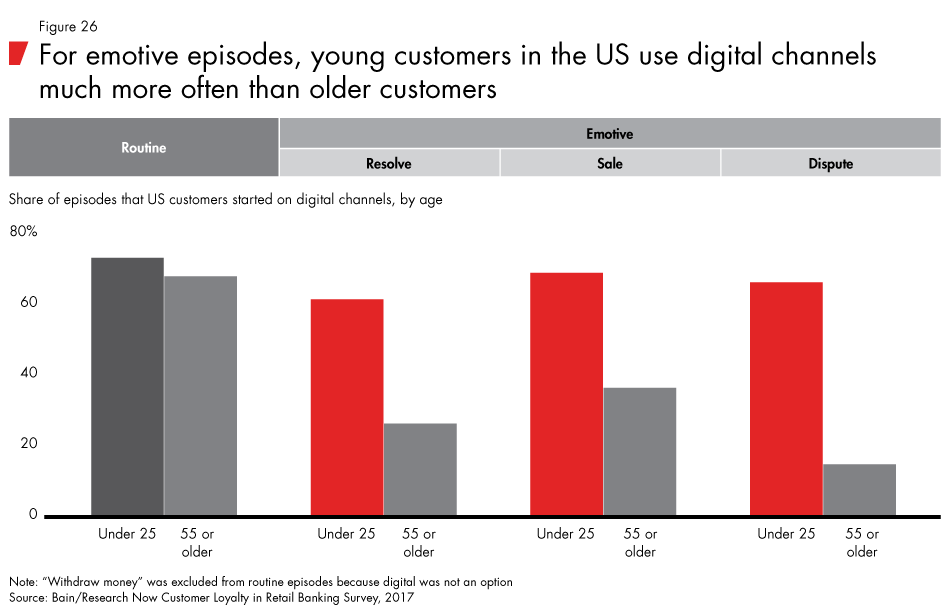
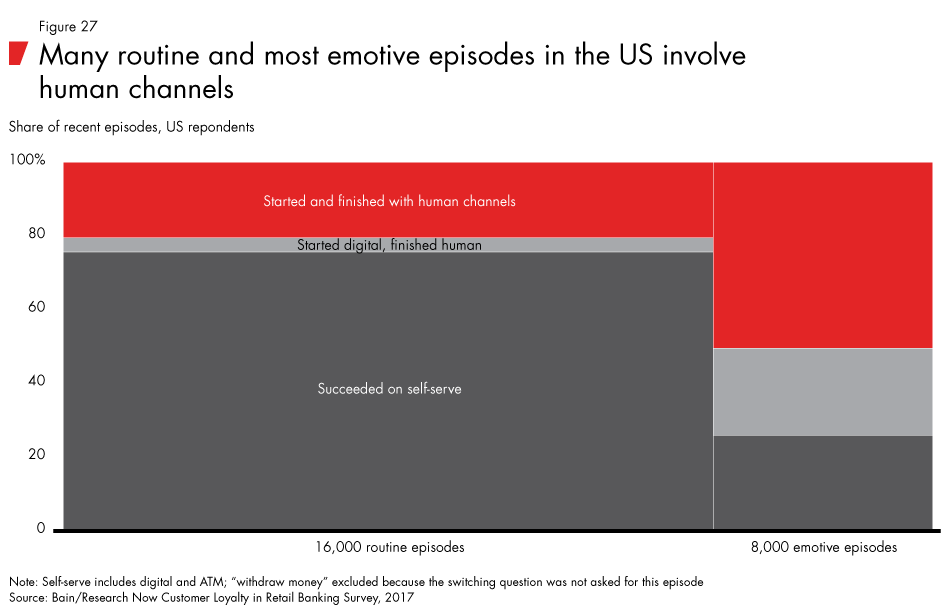
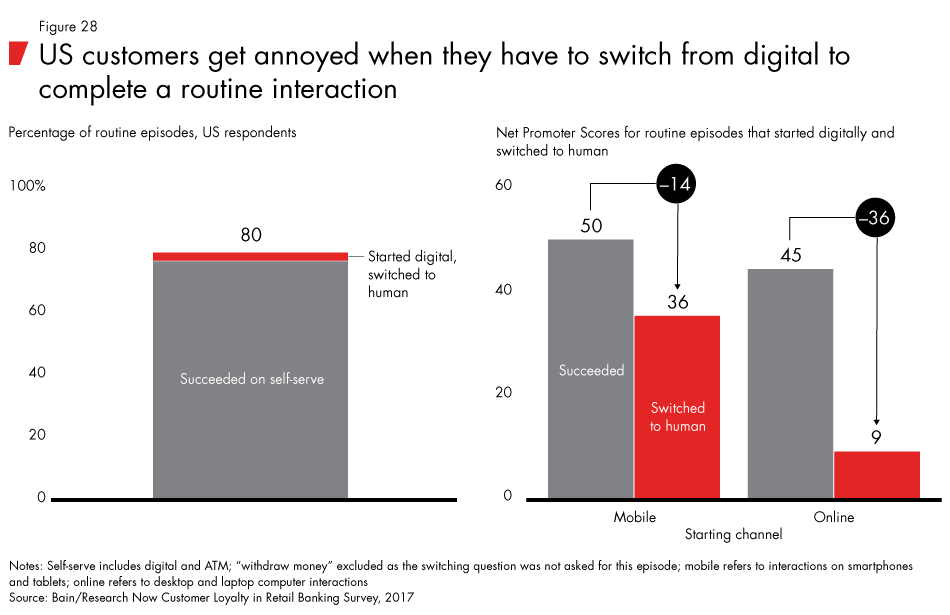
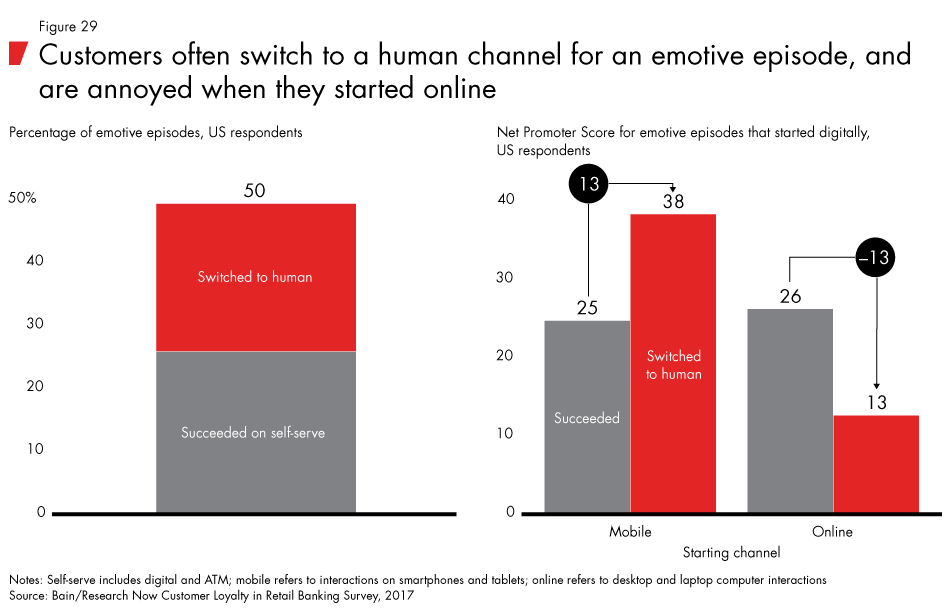
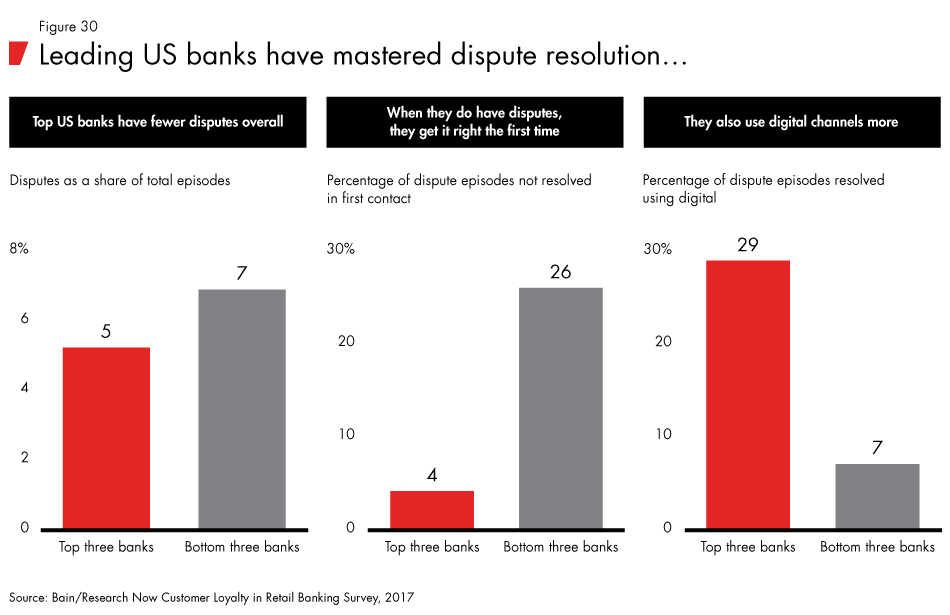
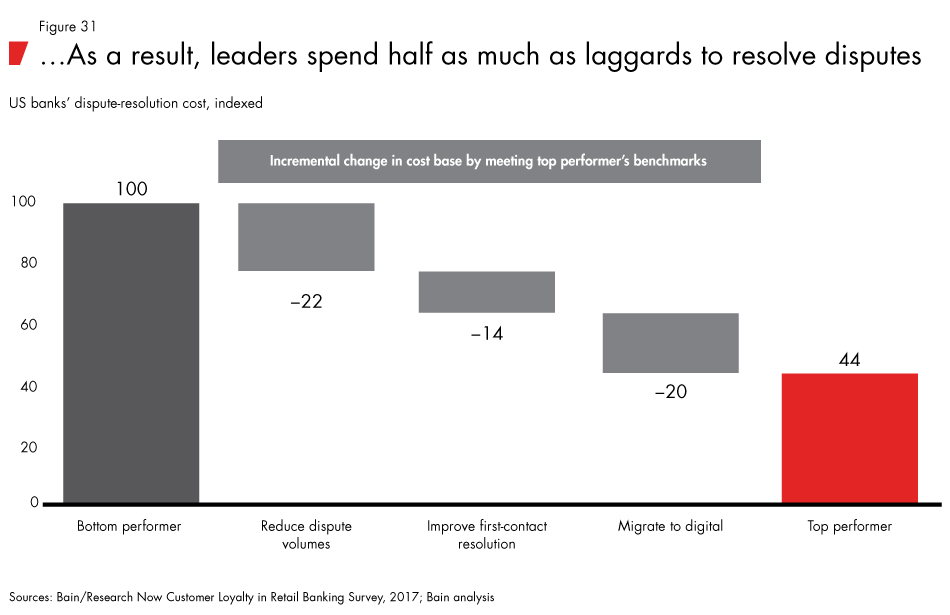
Hidden customer defection runs rampant, with banks neglecting to ask for the sale
- Banks continue to lose many product purchases to competitors. Across countries, 25% to 51% of customers (in Brazil and the UK, respectively) who bought a banking product in the past year turned to a bank other than their primary one.
- Much of this defection occurs through digital channels, particularly for credit cards. Digital purchasing is most prevalent in the UK, the Netherlands, Germany and Australia. It is least prevalent in Mexico, Chile and Malaysia.
- Stemming this tide could be more straightforward than banks realize: They have to ask for business at the right moment. Only one-fifth of US defectors were actively researching products when they decided to buy. Half of US defectors and one-third in Australia bought from a competitor because they received an offer or saw an advertisement.
- Even when consumers have bought from a competitor, they still have ties to the primary bank. At least half of defectors in multiple countries would have purchased from their primary bank if the bank had made an offer. These perceptions leave primary banks with an opening to actively pursue new business, as well as build the brand in customers’ eyes.
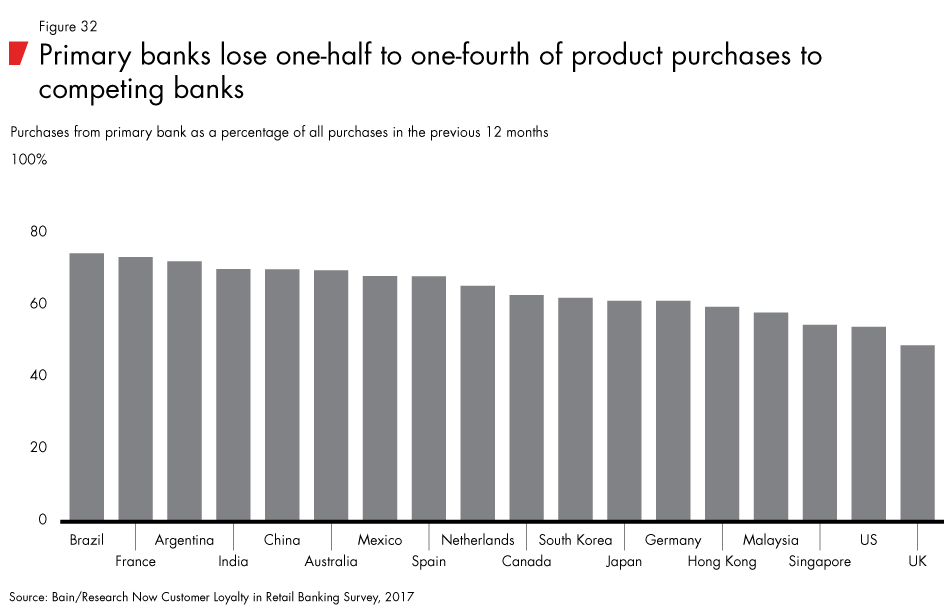
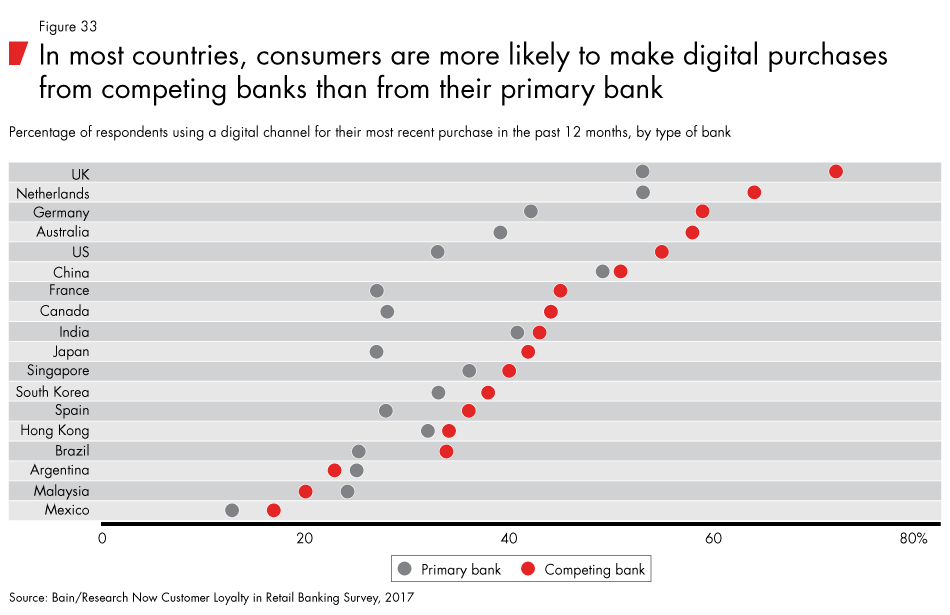
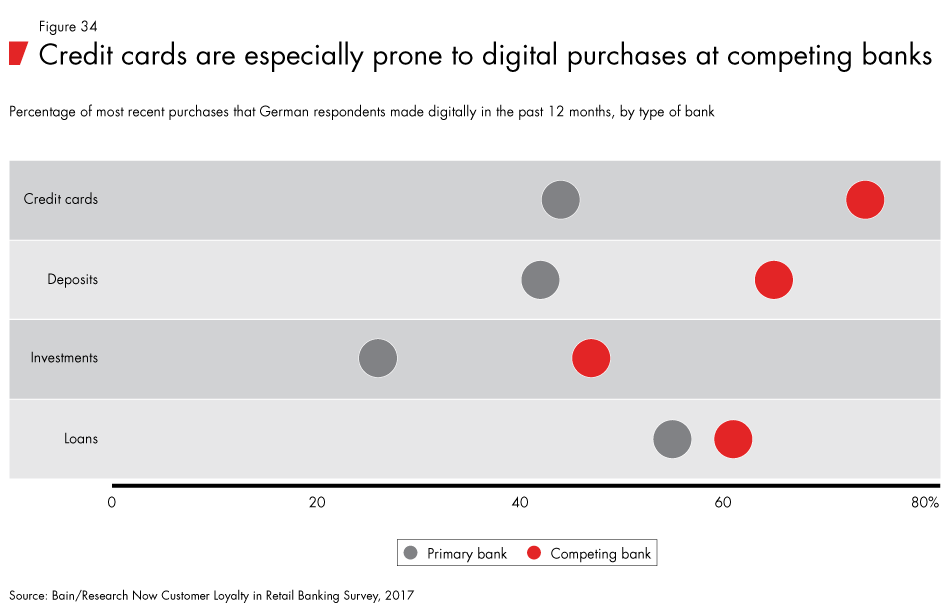
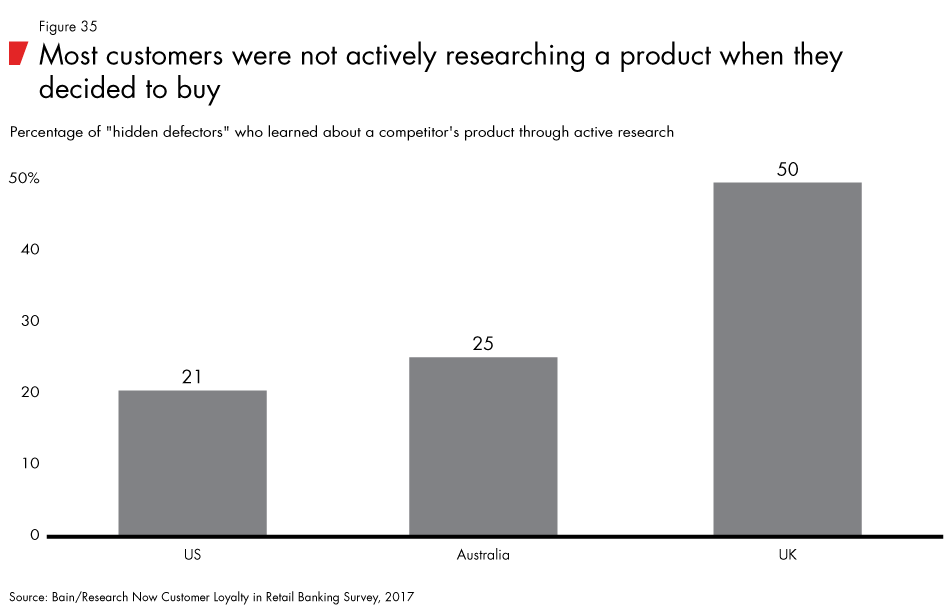
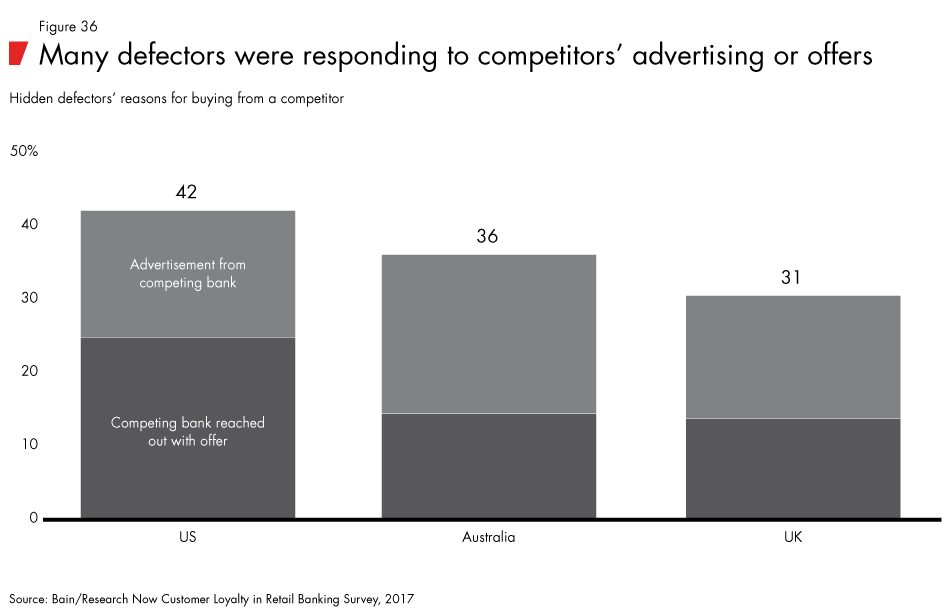
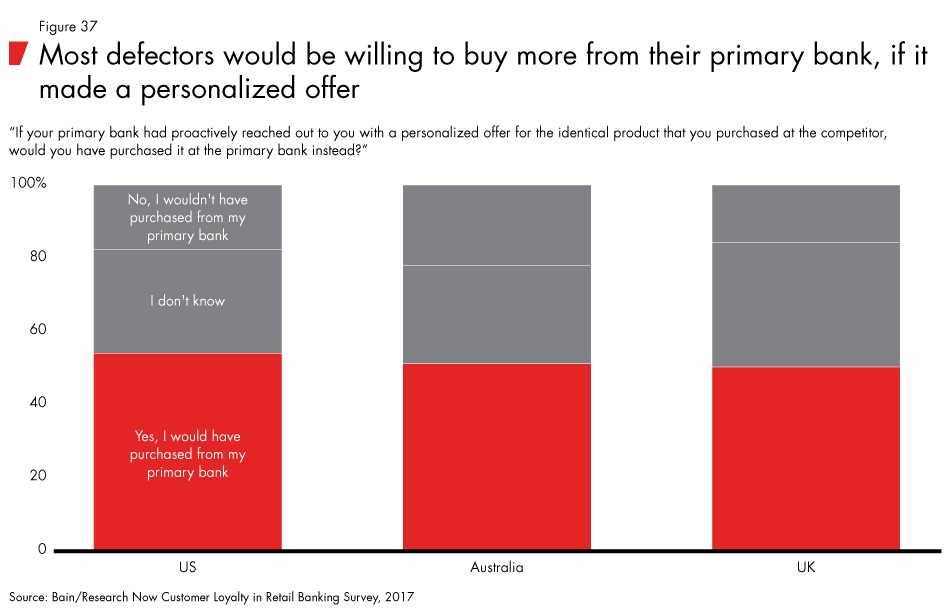
Movement on the loyalty leader boards
- Direct banks continue to lead in Net Promoter Scores relative to national, regional or smaller competitors in many countries.
- Some big banks have demonstrated sustained progress over the past few years. In Mexico, BBVA Bancomer moved up steadily in recent years to clinch the No. 2 position among traditional banks last year and has continued to narrow the loyalty gap, as it has gained market share. The bank started its digital transformation relatively early.
- For an individual bank, what matters is how it performs against peers in its market. Using that lens, Net Promoter Scores varied widely from country to country. In-country differentials between the loyalty leader and the laggard were largest in Spain, Germany, the UK, and the Northeast and Midwest regions of the US. The gaps were narrowest in the Netherlands, Mexico and South Korea.
- Only a few banks have held the top spot from year to year, including USAA in the US and First Direct in the UK.
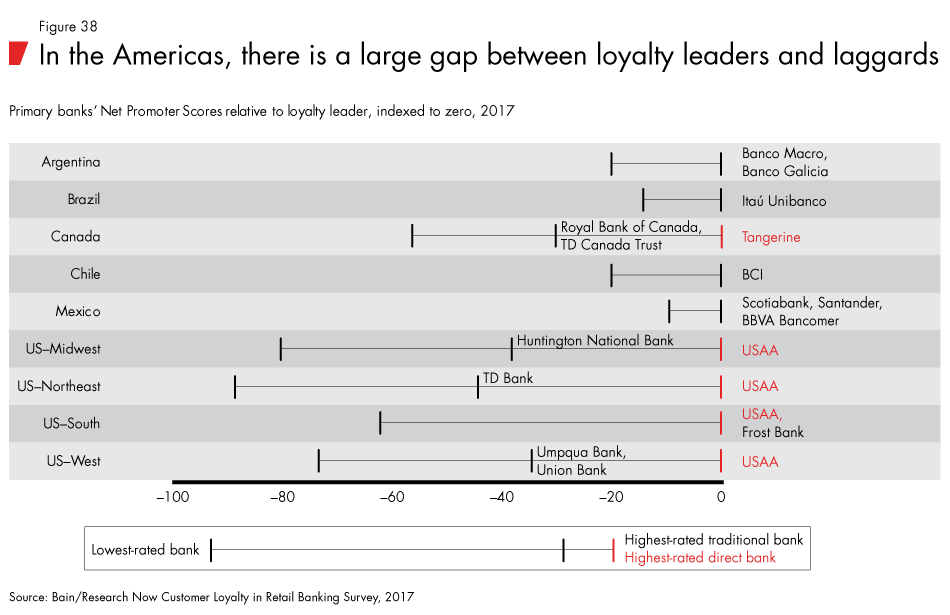
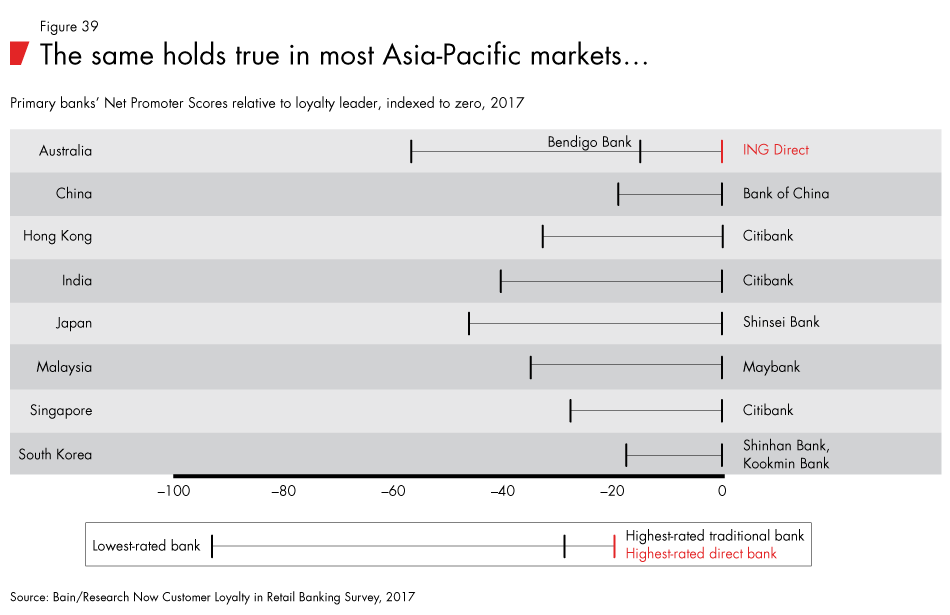
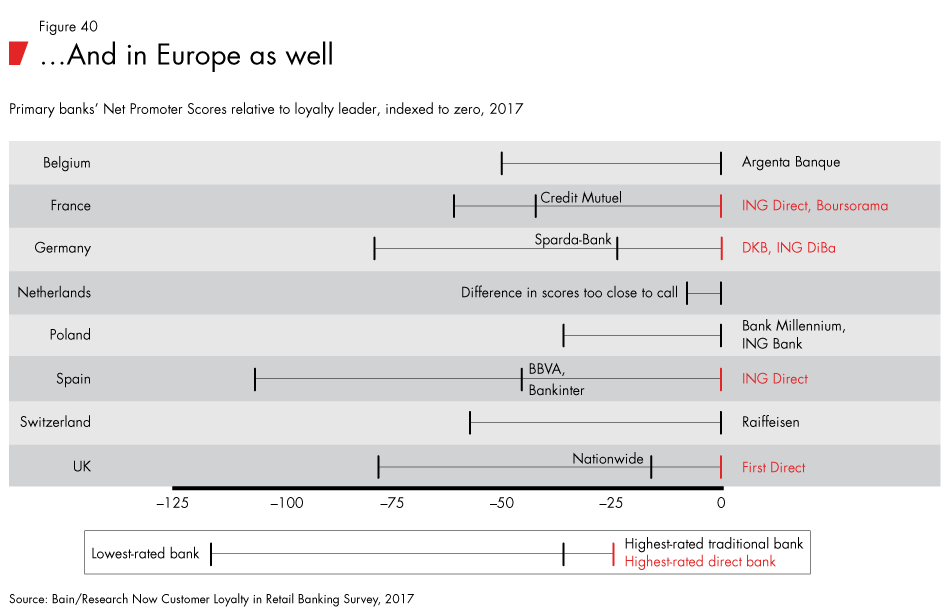
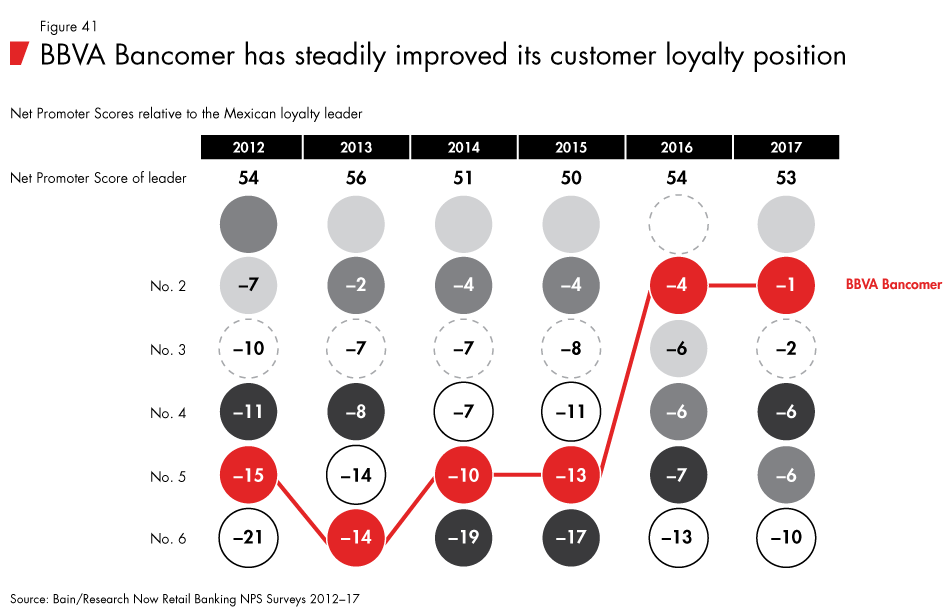
Appendix: Methodology
Bain & Company partnered with Research Now, an online global market-research organization, to survey consumer panels in Argentina, Australia, Belgium, Brazil, Canada, Chile, China, France, Germany, Hong Kong, India, Japan, Malaysia, Mexico, the Netherlands, Poland, Singapore, South Korea, Spain, Switzerland, the UK and the US. The survey’s purpose was to gauge customers’ loyalty to their principal bank and the underlying reasons customers hold their views. Conducted from July to August 2017, the survey polled 133,171 respondent consumers of national branch network banks, regional banks, private banks, direct banks, community banks and credit unions in these countries.
For most individual bank analysis, we included only banks for which we received at least 200 valid responses. In Argentina, Chile, India, Malaysia and Singapore, we included banks with at least 100 responses. In many instances, sample sizes exceeded these thresholds.
Survey questions
Respondents were first asked to identify their primary bank, then were asked the following questions to assess their loyalty to that institution:
- On a scale of zero to 10, where zero represents “not at all likely” and 10 represents “extremely likely,” how likely are you to recommend your primary bank to a friend or relative?
- Tell us why you gave your primary bank the score you did.
Ratings of zero to 6 signify detractors, 7 and 8 signify passives, and 9 and 10 signify promoters. Net Promoter Scores are calculated by subtracting the percentage of detractors from the percentage of promoters. A positive score indicates advocacy and support, while a negative score shows the opposite.
We asked what major products respondents hold with their primary bank and with other banks, and which of these products were purchased in the past year. We also asked respondents what their most recent purchase had been, and the bank and channels they used to make this purchase. Further, we asked how often they interacted through various channels to do their banking in the past three months. We also asked questions about respondents’ attitudes toward using technology companies for financial products. The remaining questions elicited demographic profile information: household income, investable assets and region of residence.
For statistical significance, the results of our data analysis are robust for the measurement of bank Net Promoter Scores by country or US region. Where our threshold for the bank’s inclusion in the Net Promoter Score rankings is a sample size of 200, the score measured for each bank is statistically significant to an 80% confidence level, with a two-tailed test of the confidence interval ranging from plus or minus 2.6% for a sample size of 979, to plus or minus 7.4% for a sample size of 200. In countries where sample sizes were smaller, confidence intervals are wider, with a maximum of plus or minus 10%.
This report was prepared by Gerard du Toit and Maureen Burns, partners in Bain’s Financial Services practice, and a team led by Christy de Gooyer, a practice area director, and David Phillips, a consultant. Team members are Madhav Jalan, Lakshay Kataria, Sidhant Law, Akash Malhotra, Jocelyne Moyer, Pranav Singh and Lavanya Srivastava. The authors thank Bain partners in each of the countries covered in the report for their valuable input and John Campbell for his editorial support.
Research Now is a global leader in digital research data for better insights and business decisions. Founded in 1999, the company was a pioneer in originating online data sampling. The company provides research data solutions for its 3,000 market research, consulting, media and corporate clients through access to over 11 million deeply profiled business professionals and consumers. Research Now currently operates in over 40 countries around the globe with locations in the Americas, Europe, the Middle East and the Asia-Pacific. For more information, please go to www.researchnow.com.
Net Promoter®, Net Promoter System®, Net Promoter Score® and NPS® are registered trademarks of Bain & Company, Inc., Fred Reichheld and Satmetrix Systems, Inc.






